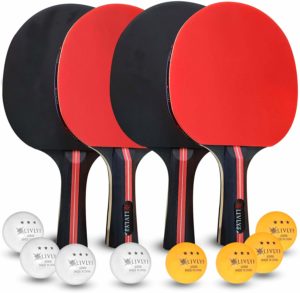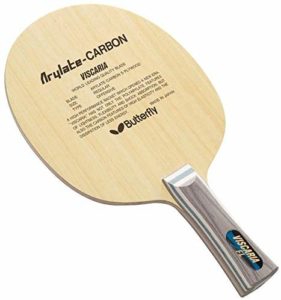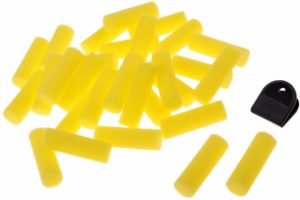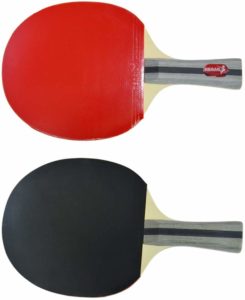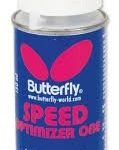There are many different types of ping pong paddles available to choose from. However, when it comes to choosing the best ping pong paddles, there is only one thing that matters how well they will perform for you.
If you’re looking to improve your game, you’ll want to make sure that you’re using the top ping pong paddles. In this article, we’ll go over how to choose the best ping pong paddles for you, based on the type of paddles you use and what you plan to do with them.
How do I choose the high-quality ping pong paddle for me
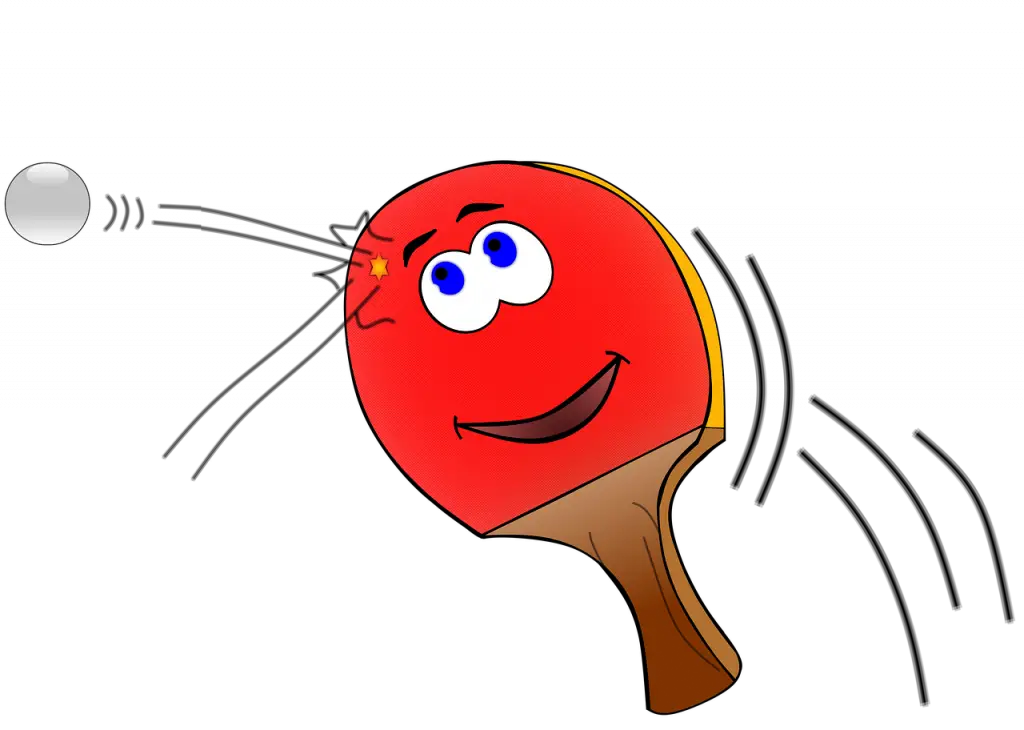
Now that we have a basic understanding of what ping pong is, we can move on to how to choose the right paddle for you.
Ping pong is an easy sport to learn, that is why so many players around the world play it. Knowing the right paddle, though, isn’t as easy, as there is a vast ocean of things to set right first. Don’t fear; we are here to guide you.
Play-style:
The first thing to consider is what play style you fall under. Whether as a professional or an amateur, this is important. There are two main play styles tagged Defensive and Offensive.
Defensive play is protecting yourself from losing, using various skills such as the Lob, the chop, the push, and the block.
All these ensure that whatever attack your opponent throws at you, you can safely get out of it first. This style is excellent for new players.
Offensive style is where a player attacks his or her opponent entirely intending to knock him or her off their game. With techniques like the smash, the hit, the counter-hit, the flip, and finally the hoop, this is most suited for more advanced players.
Sometimes as a beginner, you might be unsure which you fall into. We advise that you take a little practice run with a borrowed bat and possibly have a professional player or an advanced player watch you play and then decide which you fall under.
There is a possibility also that you can fall under both, which regularly happens to first-timers, where you end up using bits of both the offensive and the defensive style.
Don’t worry; it is a form, although not professionally, but you can begin with that and then perfect your style choice.
Play level:
Playing level is the next step to take. Paddles don’t dig a hole through your pocket, but of course, some paddles are on the higher end of the budget.
Once you realize your playing style, you should also consider how far you plan on going in this game. Are you just going at it for recreational purposes, without any interest in advancing more now than your garage or a sports club or friendly matches?
Or are you thinking of going pro no matter how little? Or are you already something of an advanced player but are in search of the best ping pong paddle for you?
Well, whatever the case may be, it is wise to choose a budget-friendly bat that fits your playing level and is sure of some degree of durability, efficiency, and effectiveness. Once you are assured of that much, then you can move on to the next step.
Grip:
The next step to consider is what hold you wish to use. To do this, let us give you a rundown on the available Grip patterns in ping pong.
The Shakehand:
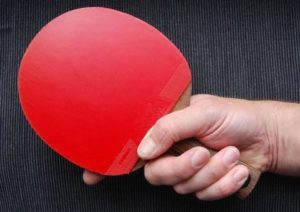
The Shakehand is by far the most popular ping pong grip in use. It looks very much like a Handshake hence the name.
In this grip, the paddle remains between a player’s thumb and the first finger, with the first finger, kept outstretched on the paddle, and the rest of the fingers wrapped around the handle.
Its’ popularity in the world of western players also earned it the name western style.
Some notable players who have kept to the form are Vladimir Samsonov, Zhang Jike, and a lot more in and out of the player of the western world.
The shake hand grip has two shades to it, the shallow shake hand and the deep Shakehand.
Shallow Shakehand Grip
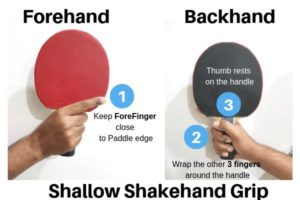
In the shallow Shakehand grip, while the first finger and other fingers remain in their position, the thumb will rest on the blade.
Pros of this method are:
- The Shakehand grip gives room to shift the angle of the paddle due to its loose grip.
- It offers to roam to move around the wrist, which in turn provides more substantial power and spin to attacked balls.
- It is usually the first style beginners feel comfortable with
- Perfect for both a front and a backhand stroke.
Cons
The only negative thing found about this grip is a situation called the cross-over point.
The players are very likely to be indecisive on which hand side to use, the front or backhand side, which can result in a losing round for inexperienced players who are not quick enough to make that decision.
Deep Shakehand Grip

And in the deep Shakehand grip, the thumb will rest on the rubber.
Pros
- It gives firm hold on the paddle which stops excess movement in a player’s hand
- Reduces flexibility for players who use controlled strokes when playing
- Good for both back and front hand strokes
- The Shakehand is the best defensive playing style for the players.
Cons:
- same as with the shallow Shakehand grip
The Penhold
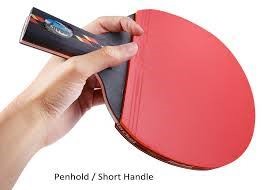
It is the second most widely known style. In this style, the thumb and the first finger are used to hold the bat with the two fingers.
And it is placed at the front, while the rest of the fingers are folded behind the bat’s head.
It is similar to how one might hood a pen. There are three types of Penhold grips; the Japanese/Korean grip, the Chinese grip, and the reverse backhand grip.
Japanese/Korean Grip
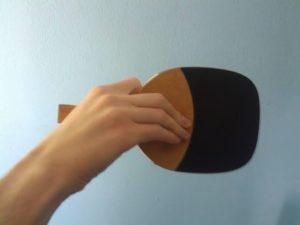
The Japanese/Korean grip: in addition to how the thumb and first finger are placed, the last three fingers are kept tightly together in a straight upright manner.
Pros
- Gives a powerful forehand stroke
- Provides a healthy spin and serve
- Suitable for players who favor a distance play
Cons
- Causes movement restrictions
- Difficulty in mastery for learners
- Causes difficulty in delivering a backhand stroke
- Needs players with prowess in foot control
Chinese Penhold:
most widely used and extremely popular amongst players in the Asian world. Players hold the racket with the blade facing down, with players almost always standing closer to the table than those who use other styles.
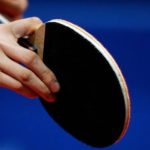
Pros
- Perfect for players who play close to the table
- Enables flexible wrist movement
- Ensures powerful attacking serves and strokes
- Perfect for front hand strokes
- There is only one side, the forehand side, which eliminates the problem of crossover.
Cons
- Due to having just one side, there is difficulty in performing any backhand movement.
There is also the reverse penholders’ style, which is not widely used. There are also several other styles that, though, do not have as much popularity, are still in use by some players in the ping pong world, such as the V grip, the Seemiller, and a host of others.
The Paddle:
The racket is the depth of it all. There is a lot to be discussed here, and you can be sure that we will leave no stone unturned.
First of all, most blades come in an inch measurement of 6 to 10; this is from top to bottom.
It comprises 6 parts, the handle, the blade, the forehand sponge, the backhand sponge, the forehand rubber, and the backhand rubber.
Sometimes you can see a fully assembled paddle, but a good number of times, they come disassembled.
Assembled paddles tend not to be favorable for advanced players, but they can be okay for beginners who are yet to understand the various available combination options.
If you have to use a thoroughly done paddle, be sure to buy from some of the more renowned names like Butterfly, Stigma, or Yasaka.
At least you are assured of quality. If you choose to assemble a paddle to your taste, then read on.
Handle:
The first thing to know when assembling your racket is the type of handle available and which best suits you. Although there is no specific best handle, there are several handles available, and it would be wise to try out a few before finally purchasing one.
The best handle should be between 100 to 102 mm long for those who need an average length, and for those who enjoy the long handles, then 103 to 104 should do fine.
Only get the short-length handle if you have chosen a Penhold style. There are five main branches of handle: the Flared, the straight, the Chinese, the anatomic, and the conic.
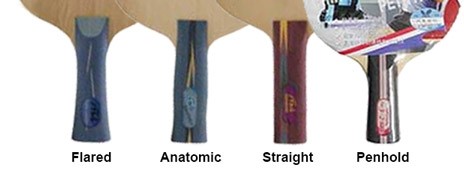
The Flared:
It is the most commonly used handle. It is thin on top and broader at the bottom
Characteristics
- Best suited for players with a forehand play prowess
- Best for a lob style play
The Straight:
the round version is the basic style of the straight handle, while the square version is a recent addition used by some ping pong production companies. It also comes in a flat shape that is used by defensive or oversized blades.
Characteristics
- It comes in round or square
- Is suitable for movement between the front and backhand
- Good for backhand power balance
The Chinese Characteristics
- Preferred by Penhold players
- Perfect for serving
- Gives wrist freedom
- Good for forehand attack
- Not suitable for backhand strokes
The Anatomic:
similar to the flared angle it differs only by the bump at the middle that fits the hand
Characteristics
- Useful for those who use the hitting technique
- Not suitable for the lop technique
- Not very good for long-distance play
Conical Characteristics
- Not a popular use
- Useful for those using all-round styles
- It gives discomfort to those with big hands.
There are more handle types like the Donic Dotec handles that are very comfortable, almost like the anatomic handles.
It is very suitable for those hat suffered injuries to the wrist. And there are unique shapes that come in all sorts of weird styles but can be beneficial to those who suffer from varied disabilities.
As added advice, if most rackets available to you seem too small at the handle, you can use grip tape for a better feel.
 Blade:
Blade:
Most professional blades are 85% natural wood with an allowance of bits of carbon or glass fiber or compressed wood; every added material cannot exceed 7.5% of a total thickness of 0.35mm.
But starters can always use non-professional blades and, as they advance, can decide which quality of blade suits their game style.
Some blades are made of plastic or little wood compositions, though not suited for professional use, they can be handy for beginners who want to try out the ping pong game for the first time.
Composite blades are made for the speed and consistency and less for the spin of the ball, and blades. This doesn’t mean that one cannot find a composite blade that is on par with the turn and feel capacity of a wooden blade.
And there are those wood-based blades that are also similar in the consistency and speed of composite blades, it all relies on which blade you can find.
 Forehand and backhand sponge:
Forehand and backhand sponge:
Rarely available separately from the rubber, the sponge can come alone, and making a choice depends on your grip and play style.
There are a few measurements available for sponge, 1.8mm, 2.0mm, 2.1mm, 2.2mm, 2.3mm, or max.
The sponge is used to compress ( when a ball pushes down the sponge) and to store energy ( when the sponge bounces back the ball).
Sponges ranging from 1.6 to 2.5mm are used mostly by offensive players, and those from 1.5 to 2.0 are used by all-around players, while defensive players mainly use the OX, meaning no sponge to 1.6mm. For new players, it is advisable to use a thinner sponge
The Rubber:
Most times, come pre-attached to the sponge, but if you have to choose which rubber, then you need to know the available types and their uses.
The ping pong rubber is a major determinant of how well you play, and there are two main types of rubber sheets the inverted and the pimple.
The inverted rubber sheets are also called the smooth rubber sheets because the pimples or otherwise called pips (the sort of spiky tops of the rubber) are hidden inside the sponge, thereby showing off the smooth side.
It provides the most spin, is good for hits and lops, all-around, and defensive players. There are two types of inverted or smooth rubber sheets: Tacky or sticky rubber and the Anti-Topspin. Their difference is in their spin generation and grip.
Anti-Topspin: it has a smooth surface, which gives little and slows spin and speed. It is also used more for the block technique.
It also has low friction, which only nullifies spins created by the opponent, with its ability to reverse the balls’ spin the anti-spin gives its players the benefit of disorienting the opponent since it is still a not so popular type of rubber.
Also beneficial in slowing down a ball, it gives control to players who use the chopping technique. Their weak attacks make them more used as a backhand piece.
Tacky or Sticky rubber: used best in ensuring ball spin basically because of the tackiness in the rubber that meets the ball.
This means that there is a direct correlation between how tacky the rubber is and how many spins the ball will have.
The higher the rubber tackiness is it provides more topspin, and the lower the tackiness of the rubber, it generates lower spin.
This makes it perfect for lop and spin techniques, however, there is a negative to this type of rubber.
That being that players need to figure out the amount of energy the opponents’ ball is spinning with and how much the impact on the player’s racketball will cause, with this knowledge, players can determine the best angle to use.
The next type is the pimpled rubber, which shows off the pimpled side of the rubber and hides the smooth side. Popular among beginners this type is further divided into two the short pimple and the long pimple
The short pip: their pimples are broad with a little stick; its bumpy surface is most times used as a means of not creating a lot of spin in the game since it has low friction.
When there is no underlying sponge to the short pip rubber, it is the referee to as Hard Rubber.
Short pip is used a lot by players who stand closer to the table, all around, and defensive players. Short pips give control and work well for the smash and block techniques.
Because of its ability to reduce the ball spin, it is perfect for performing return serve as long as the player knows the right angle and power to use.
Long pips: they contain longer pips than short pips. They are long and thin and are widely used by defensive players. They slow down and reverse the spin played by the other competitor.
Best suited for a defensive player, offensive players find it hard to play with it, this makes it a popular choice for single side use. But just like the anti-spin rubber, they can cause disorientation to the opponents.
The sponge and rubber both determine the spin, which refers to the turn of the ball when a loop technique is used.
It is highly reliant on many factors other than the rubber spinning rate, with its sensitivity to strokes played and the speed of the incoming ball.
Speed refers to the swiftness of the ball, which also relies on different factors like the blade, the thickness of the sponge, or different techniques.
It is also used to determine the efficiency of one rubber to the other, and it also refers to the rate at which the ball goes back at forth between the players.
And control of the ball, which depends on the thickness and hardness of both, to get proper monitoring, you would need to give up on one of spin or speed.
Players who play defense games are more likely to use rubbers with slow speed while offensive players go for high-speed rubbers. Note that the more speedy a rubber can get a ball to be, the harder it will be to manage.
Sponges with higher thickness give better speed and spin while giving more paddle weight and a cushion feel, and those with more thinness give better control while providing a feeling of wood and lightweight.
Other things to consider when choosing the best ping pong paddle are the
Glue: thought the time comes side by side the rubber, still if you have to buy them separately ensures that you purchase a professional rubber glue that is water-based.
They should come fully packed with the cleaners. Some adhesives have been speculated to support the speed of the ping pong rubber. There are two types of glue used by ping pong players, quick glue sheets and water-based ping pong glue.
Side tape: also known as edge tape, is used to improve the ping pong racket’s balance and reduce the possibility of early rubber peeling. Set around the edge of the ping pong bat, this piece of equipment can be used to cover only the wooden part of the bat or the wood corner of the rubber.
Although not a compulsory accessory, it is still popularly used by players because of the cosmetic finishing it gives to their paddles.
The tape can be as comprehensive as 12mm and can be used to hide rough bat edges and poor rubber gluing finishes.
Grip tape: they are used to give firmness and control to the ping pong handle. Used less by professional ping pong players, the grip tape is still regarded as an accessory to the paddles.
It also ensures that new players don’t have their rackets sliding about their hands when playing. The grip tape also works as a cosmetic attachment to a players paddle, since they come in various colors, favorable to each player’s style
How to choose the best ping pong paddles – Ultimate guide
Ping pong has become a widely played sport around the world with players of all ages and gender, and with the ease of learning and a relatively cheaper cost of equipment (that is with other big-name sports), the ping pong market is at its peak.
Buying a paddle is the most personal part of a ping pong game, as it reflects who the players are and their gaming techniques and prowess.
Most players have taken great care to buy the right paddle for their gaming needs, and why shouldn’t you too?
Whether you are a new player, an advancing player, an already advanced player, or a pro, you will be in need at some point in time of paddle purchase or change.
If that is so, then this guide is for you. Here are the essential things to keep in mind when buying a paddle.
Budget
Cost is a very crucial point; this lets you know what exactly you are willing to get.
If you are budget tight then you should keep in mind that you cannot get some of the best qualities with a limited budget, a bat-like Butterfly balsa Carbo x5- FL, is a top-notch pro paddle and won’t come budget-friendly.
So if you wish to get the very best quality and durability you should be open to a budget of $200 and more, But again ping pong sports has a bat for all, and one can find bats of $60 and below like the Stiga Evolution which can cost around $40-50.
Assembly
Pre or assemble bats: would you prefer a pre-assembled bat, or would you prefer buying a completely unassembled bat.
Remember that purchasing a pre-assembled bat means that there might be things you don’t like about it and might not be able to change immediately or at all.
If you can live with that, then ensure you buy from producers with some reputation in the ping pong world, try Yasaka or Stiga or Butterfly or Killerspin.
All these are reputable, and you can at least believe that they won’t want to pull down their name with inferior products.
If you choose to assemble a bat yourself then be prepared to take on some work and trust me when you are done, you will be glad, lookout out for a good rubber, sponge (if the sponge isn’t already attached to the rubber), blade, glue and handle. Best to go for the same product.
Blade Type
Blade: when buying a blade alone ( this is if you choose to assemble your paddle), look out for the following specs if you decide to go for a composite blade over an all-wood blade.
If it is a blade made of a single material, then look for those that have one of these Carbons ( most times black), Zylon ( yellow), Kevlar ( blue), Aralyte ( cream in color), or fiberglass ( most times dyed but naturally transparent colored).
If it is a mixed material composite blade, then look out for Carbon and Aralyte, Carbon and Kevlar or Carbon, and Zylon.
Play-style
Buy only paddles that favor your play style concerning the handle, blade, and rubber.
Ensure that you know beforehand your playing style, defense or offense, and your grip preference, shake a hand, pen grip, V grip, or others.
Once you are sure about that, then your shopping would be a lot easy.
Review
Just to give you some more confidence in your buying choice, check out the product you wish to buy beforehand. Many reports are showing the complete detail of many ping pong paddle products.
Look out for the pros and cons and then the specifications, and lastly, customer reviews and see how well you can manage that product, if it suits you and how best to keep it long-lasting.
It’s less advisable to buy newly named products, especially when you are budget tied or when you plan on using them professionally, you might be in for an unpleasant surprise.
Stick to those who have stood the test of time and those that might even offer some warranty.
Once you have done all these checks, you are sure to be purchasing the paddle for you, and if done right, you just might land yourself a signature paddle.
Conclusion
In conclusion, there are a lot of things to consider when choosing the best ping pong paddle. The most important thing to look for is the material of the ping pong paddle. Look for a paddle made of wood, plastic, or composite. The paddle should also be lightweight, comfortable, and durable.

Hi, My name is Benjamin Fink and I am the author of the ping pong reviewed blog. I am a sports person learning and sharing my knowledge with others about ping pong and other sports.
I have been playing ping pong for the last 17 years and teaching people about the game and writing new things about the game through this blog When finding something new. I have participated in serious ping pong tournaments in my country.

